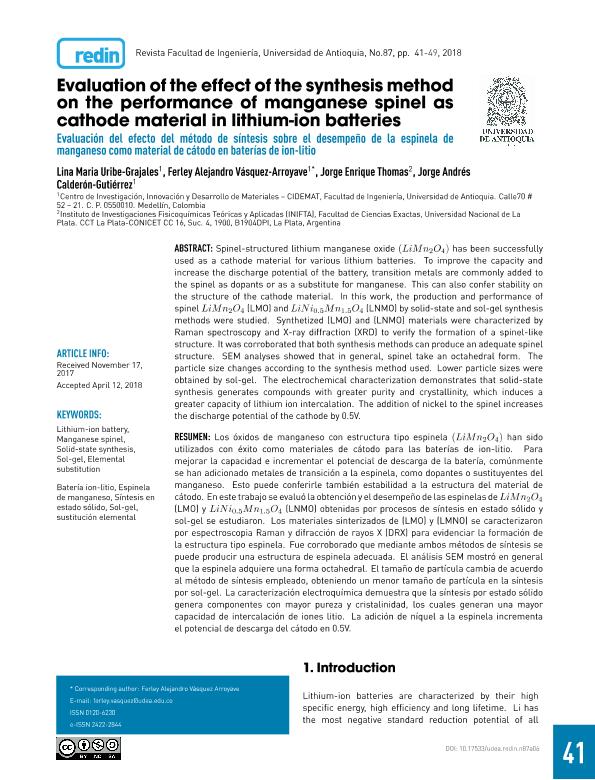Mostrar el registro sencillo del ítem
dc.contributor.author
Uribe Grajales, Lina María
dc.contributor.author
Vásquez Arroyave, Ferley Alejandro
dc.contributor.author
Thomas, Jorge Enrique

dc.contributor.author
Calderón Gutiérrez, Jorge Andrés
dc.date.available
2022-02-11T04:45:38Z
dc.date.issued
2018-04
dc.identifier.citation
Uribe Grajales, Lina María; Vásquez Arroyave, Ferley Alejandro; Thomas, Jorge Enrique; Calderón Gutiérrez, Jorge Andrés; Evaluation of the effect of the synthesis method on the performance of manganese spinel as cathode material in lithium-ion batteries; Imprenta Univ Antioquia; Revista Facultad de Ingeniería Universidad de Antioquia; 87; 4-2018; 41-49
dc.identifier.issn
0120-6230
dc.identifier.uri
http://hdl.handle.net/11336/151849
dc.description.abstract
Spinel-structured lithium manganese oxide (LiMn2O4) has been successfully used as a cathode material for various lithium batteries. To improve the capacity and increase the discharge potential of the battery, transition metals are commonly added to the spinel as dopants or as a substitute for manganese. This can also confer stability on the structure of the cathode material. In this work, the production and performance of spinel LiMn2O4 (LMO) and LiN i0.5Mn1.5O4 (LNMO) by solid-state and sol-gel synthesis methods were studied. Synthetized (LMO) and (LNMO) materials were characterized by Raman spectroscopy and X-ray diffraction (XRD) to verify the formation of a spinel-like structure. It was corroborated that both synthesis methods can produce an adequate spinel structure. SEM analyses showed that in general, spinel take an octahedral form. The particle size changes according to the synthesis method used. Lower particle sizes were obtained by sol-gel. The electrochemical characterization demonstrates that solid-state synthesis generates compounds with greater purity and crystallinity, which induces a greater capacity of lithium ion intercalation. The addition of nickel to the spinel increases the discharge potential of the cathode by 0.5V.
dc.description.abstract
Los óxidos de manganeso con estructura tipo espinela (LiMn2O4) han sido utilizados con éxito como materiales de cátodo para las baterías de ion-litio. Para mejorar la capacidad e incrementar el potencial de descarga de la batería, comúnmente se han adicionado metales de transición a la espinela, como dopantes o sustituyentes del manganeso. Esto puede conferirle también estabilidad a la estructura del material de cátodo. En este trabajo se evaluó la obtención y el desempeño de las espinelas deLiMn2O4 (LMO) y LiN i0.5Mn1.5O4 (LNMO) obtenidas por procesos de síntesis en estado sólido y sol-gel se estudiaron. Los materiales sinterizados de (LMO) y (LMNO) se caracterizaron por espectroscopia Raman y difracción de rayos X (DRX) para evidenciar la formación de la estructura tipo espinela. Fue corroborado que mediante ambos métodos de síntesis se puede producir una estructura de espinela adecuada. El análisis SEM mostró en general que la espinela adquiere una forma octahedral. El tamaño de partícula cambia de acuerdo al método de síntesis empleado, obteniendo un menor tamaño de partícula en la síntesis por sol-gel. La caracterización electroquímica demuestra que la síntesis por estado sólido genera componentes con mayor pureza y cristalinidad, los cuales generan una mayor capacidad de intercalación de iones litio. La adición de níquel a la espinela incrementa el potencial de descarga del cátodo en 0.5V.
dc.format
application/pdf
dc.language.iso
eng
dc.publisher
Imprenta Univ Antioquia

dc.rights
info:eu-repo/semantics/openAccess
dc.rights.uri
https://creativecommons.org/licenses/by-nc-sa/2.5/ar/
dc.subject
LITHIUM-ION BATTERY
dc.subject
MANGANESE SPINEL
dc.subject
SOLID-STATE SYNTHESIS
dc.subject
SOL-GEL
dc.subject
ELEMENTAL SUBSTITUTION
dc.subject.classification
Físico-Química, Ciencia de los Polímeros, Electroquímica

dc.subject.classification
Ciencias Químicas

dc.subject.classification
CIENCIAS NATURALES Y EXACTAS

dc.title
Evaluation of the effect of the synthesis method on the performance of manganese spinel as cathode material in lithium-ion batteries
dc.title
Evaluación del efecto del método de síntesis sobre el desempeño de la espinela de manganeso como material de cátodo en baterías de ion-litio
dc.type
info:eu-repo/semantics/article
dc.type
info:ar-repo/semantics/artículo
dc.type
info:eu-repo/semantics/publishedVersion
dc.date.updated
2021-04-23T19:06:36Z
dc.journal.number
87
dc.journal.pagination
41-49
dc.journal.pais
Colombia

dc.journal.ciudad
Medellín
dc.description.fil
Fil: Uribe Grajales, Lina María. Universidad de Antioquia; Colombia
dc.description.fil
Fil: Vásquez Arroyave, Ferley Alejandro. Universidad de Antioquia; Colombia
dc.description.fil
Fil: Thomas, Jorge Enrique. Consejo Nacional de Investigaciones Científicas y Técnicas. Centro Científico Tecnológico Conicet - La Plata. Instituto de Investigaciones Fisicoquímicas Teóricas y Aplicadas. Universidad Nacional de La Plata. Facultad de Ciencias Exactas. Instituto de Investigaciones Fisicoquímicas Teóricas y Aplicadas; Argentina
dc.description.fil
Fil: Calderón Gutiérrez, Jorge Andrés. Universidad de Antioquia; Colombia
dc.journal.title
Revista Facultad de Ingeniería Universidad de Antioquia

dc.relation.alternativeid
info:eu-repo/semantics/altIdentifier/url/https://revistas.udea.edu.co/index.php/ingenieria/article/view/329266
dc.relation.alternativeid
info:eu-repo/semantics/altIdentifier/doi/http://dx.doi.org/10.17533/udea.redin.n87a06
Archivos asociados
